1. Eastern Diamondback Rattlesnake – The King of American Vipers

If there’s one snake that truly embodies the word “deadly,” it’s the Eastern diamondback rattlesnake. According to National Geographic, this massive pit viper, found primarily in the southeastern U.S., is the largest rattlesnake species in North America, sometimes growing over 7 feet long. Its size alone is enough to command respect, but what makes it truly dangerous is its potent venom. A single bite delivers a powerful cocktail of hemotoxins that destroy tissue, disrupt blood clotting, and cause excruciating pain. Without treatment, the venom can lead to internal bleeding, organ failure, and, in some cases, death.
Researchers warn that while these snakes prefer to avoid humans, they will stand their ground if threatened. Their distinctive rattle serves as a warning, but those who ignore it do so at their own risk. Despite their fearsome reputation, Eastern diamondbacks play a crucial role in the ecosystem, controlling rodent populations. However, habitat destruction and human fear have led to declining numbers, making conservation efforts more important than ever.
2. Western Diamondback Rattlesnake – The Desert’s Coiled Assassin

The Western diamondback rattlesnake is a well-known inhabitant of the arid landscapes of the southwestern U.S. From Texas to California, this species is responsible for more snakebite incidents than any other rattlesnake in the country. Unlike its Eastern cousin, the Western diamondback is more aggressive and quicker to strike when it feels threatened. It delivers a hefty dose of venom that breaks down muscle tissue, causes severe swelling, and leads to intense pain that can last for weeks. In extreme cases, a bite can result in permanent damage or even amputation.
Field herpetologists say that the Western diamondback’s bite is dangerous not just because of the venom but because of its unpredictability. These snakes have a shorter fuse than other rattlers. If you get too close, they don’t always give a lengthy warning before striking. The Western diamondback is often encountered on hiking trails, ranch lands, and even suburban yards. While fatalities are rare with prompt medical treatment, ignoring a bite can have devastating consequences. If you ever hear the chilling sound of a rattle in the desert, it’s best to freeze and carefully back away—fast.
3. Mojave Rattlesnake – The Most Toxic Rattler in the U.S.
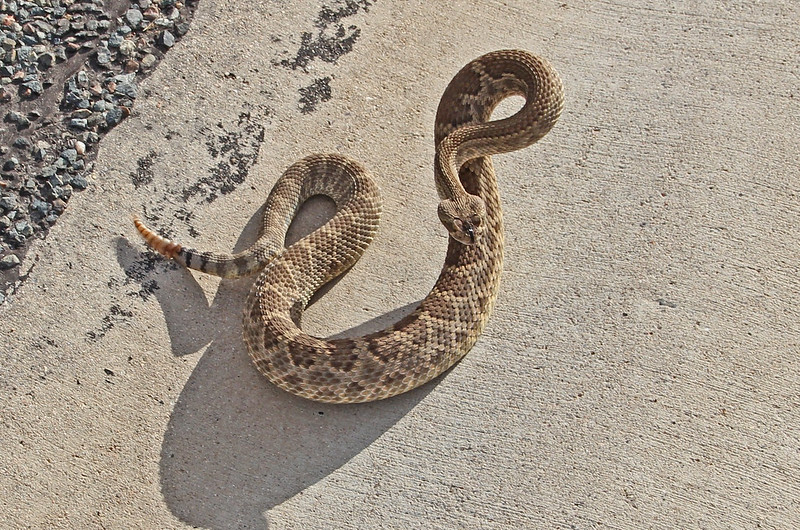
If rattlesnakes had a hierarchy of danger, the Mojave rattlesnake would sit at the top. Nicknamed the “Mojave green” for its olive-toned scales, this species is infamous for having the most potent venom of any rattlesnake in North America. What makes it especially terrifying is its unique venom composition—unlike other rattlesnakes that primarily use hemotoxins, the Mojave rattlesnake combines neurotoxins with hemotoxins. This means that not only does its bite cause tissue damage, but it also attacks the nervous system, leading to paralysis, respiratory failure, and, in severe cases, death.
Venom researchers stress just how unpredictable a Mojave rattlesnake bite can be. Some victims report feeling fine for the first few hours, then suddenly their muscles start shutting down. That delayed reaction can be deadly if medical help isn’t sought immediately. The Mojave rattlesnake is found in desert regions across California, Arizona, Nevada, and New Mexico, often blending seamlessly into the sand. Unlike some rattlesnakes that prefer to flee, the Mojave rattler is known for standing its ground. If you ever find yourself in its territory, watch your step—this snake is not one to mess with.
4. Cottonmouth – The Water’s Silent Predator
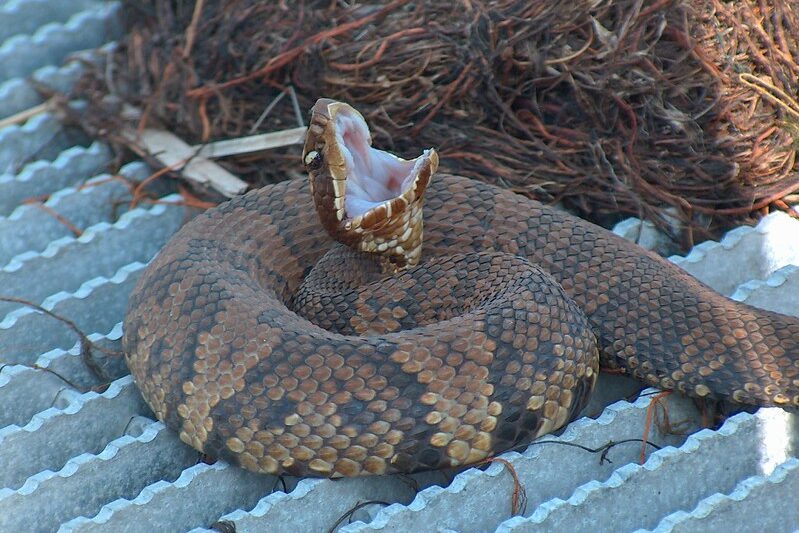
The cottonmouth, also known as the water moccasin, is the only venomous water snake in the U.S., and it’s one of the most intimidating. Found in swamps, marshes, and rivers throughout the Southeast, this semi-aquatic pit viper is notorious for its fearlessness. Unlike other snakes that slither away at the first sign of danger, cottonmouths are known to hold their ground, sometimes even advancing toward intruders with their mouths wide open, revealing the stark white interior that gives them their name. Their venom is a destructive mix of hemotoxins and cytotoxins, which cause severe swelling, tissue destruction, and intense pain.
Biologists who study cottonmouth behavior, say their reputation as overly aggressive is exaggerated but not entirely unwarranted. They don’t go looking for a fight, but they won’t back down from one either. Many reported encounters happen when people accidentally step too close while fishing or swimming. Their bites, while rarely fatal with medical treatment, can lead to permanent scarring and muscle damage. If you’re in their territory, the best strategy is to give them space—because once a cottonmouth feels threatened, it won’t hesitate to strike.
5. Coral Snake – The Colorful but Deadly Lurker
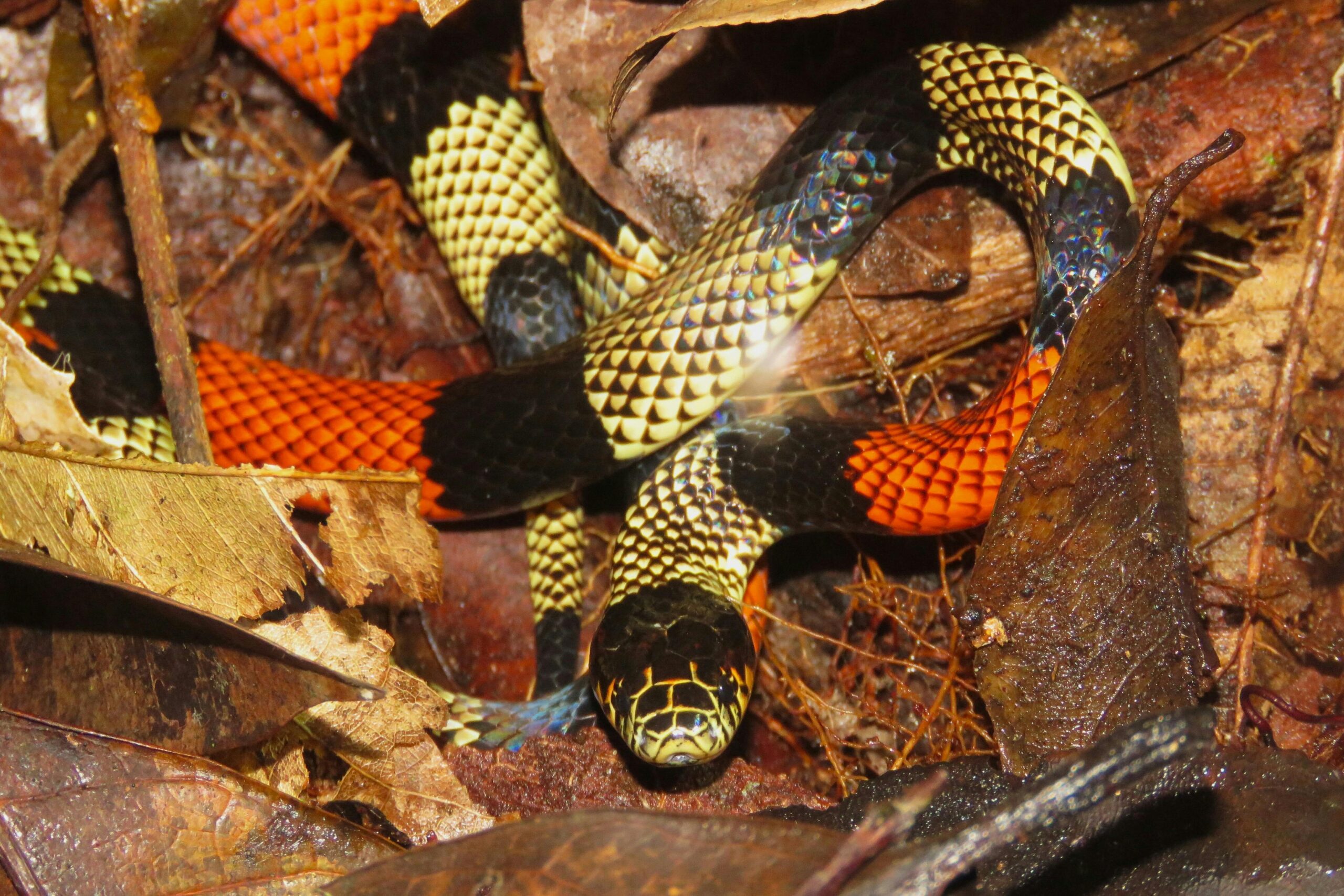
The coral snake might not look as intimidating as a rattlesnake or cottonmouth, but don’t let its small size and vibrant colors fool you—this snake carries one of the most powerful venoms in North America. With red, yellow, and black bands running along its body, the coral snake follows the well-known rhyme: “Red touches yellow, kill a fellow; red touches black, friend of Jack.” Unlike pit vipers, which have large fangs and a quick strike, coral snakes have small, fixed fangs and must chew on their prey to inject venom. But once the venom is in, it’s devastating—causing paralysis, respiratory failure, and, if untreated, death.
Snake venom specialists explain that coral snake bites are rare, but their danger lies in the delayed onset of symptoms. Victims may feel fine for several hours, then suddenly experience slurred speech, muscle weakness, and difficulty breathing. Found mainly in the southeastern U.S., from Florida to Texas, coral snakes spend most of their time hidden under leaf litter, logs, or burrowing underground. Because they’re secretive and non-aggressive, bites are uncommon, but when they do happen, they require immediate medical attention. Antivenom is available, but it’s not always easy to find, making prevention key—if you see one, admire its beauty from a distance and move on.
6. Timber Rattlesnake – The Silent But Lethal Hunter
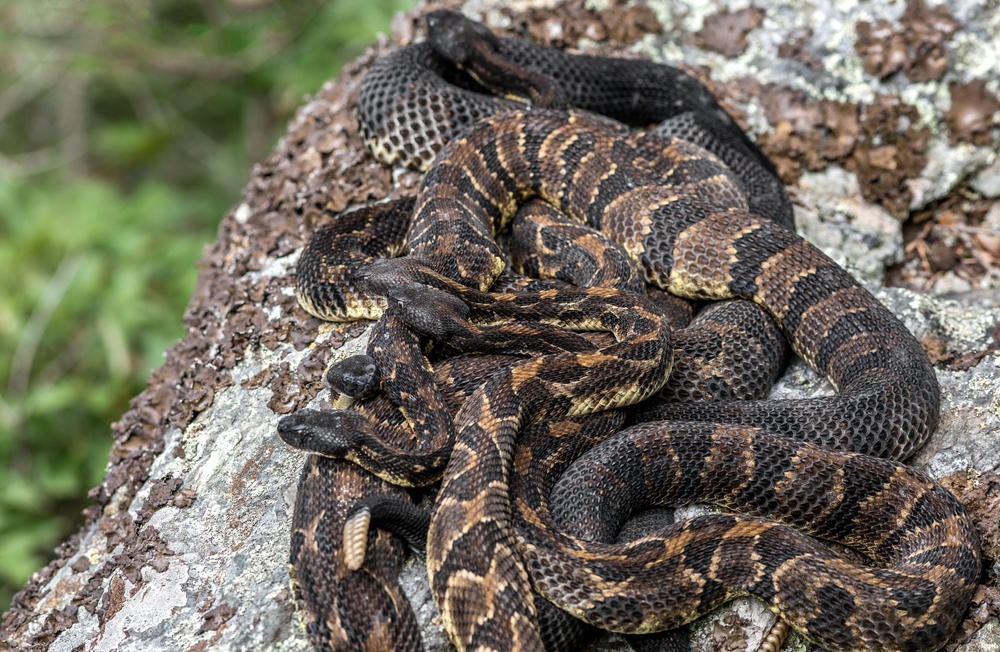
The timber rattlesnake, sometimes called the canebrake rattlesnake, is one of the most widespread venomous snakes in the eastern U.S. Found in forests, rocky outcrops, and even rural farmlands, this snake is known for its impressive camouflage, which makes it almost invisible among fallen leaves and underbrush. While timber rattlesnakes are generally less aggressive than their western cousins, their venom is no less dangerous. A bite from this snake delivers a potent combination of hemotoxins and neurotoxins, causing massive swelling, tissue destruction, and, in severe cases, blood clotting disorders that can lead to organ failure.
Herpetologists describe the timber rattlesnake as “a master of patience,” explaining that it relies on ambush tactics rather than active pursuit. “They’ll sit motionless for hours, waiting for the perfect moment to strike,” she says. Despite their deadly potential, timber rattlesnakes play a vital role in controlling rodent populations and typically avoid human encounters. However, when surprised or cornered, they won’t hesitate to rattle and strike. Hikers and campers should always be cautious when stepping over logs or reaching into brush, as these snakes can be hard to spot until it’s too late.
7. Copperhead – The Master of Camouflage and Close Encounters
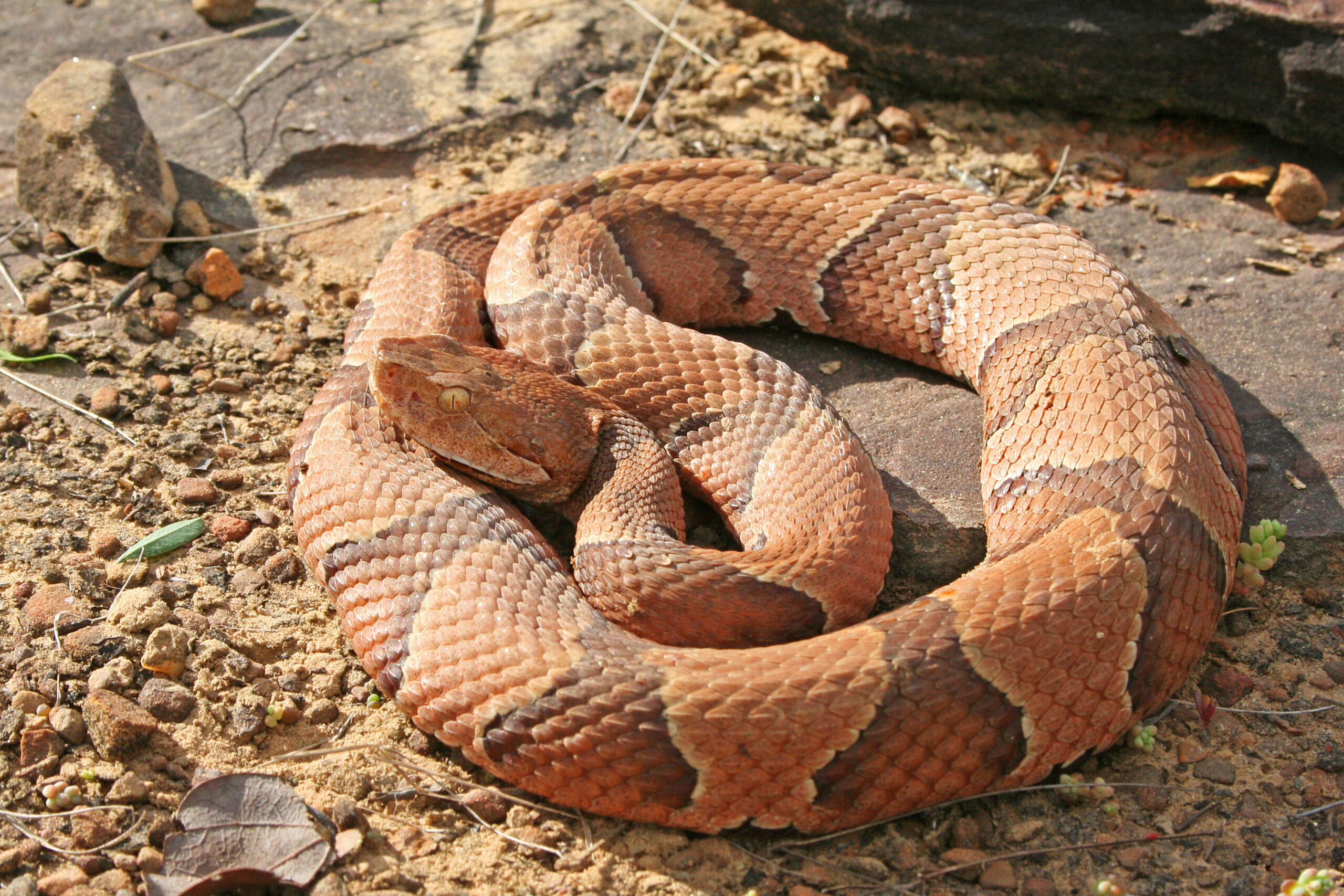
Copperheads are arguably the most frequently encountered venomous snakes in the U.S., thanks to their incredible ability to blend into fallen leaves and forest floors. Their distinct copper-colored heads and hourglass-patterned bodies make them nearly invisible in wooded areas, leading to numerous accidental bites each year. While their venom is not as potent as that of rattlesnakes or coral snakes, it’s still powerful enough to cause extreme pain, swelling, and, in some cases, serious medical complications. Unlike other venomous snakes, copperheads tend to freeze rather than flee when approached, making them especially easy to step on.
Field researchers specializing in snake behavior, warn that copperheads are responsible for the highest number of venomous bites in the U.S. each year. “They don’t always give a warning before striking, which is what makes them so dangerous”. Found throughout the eastern and central U.S., copperheads thrive in forests, grassy fields, and even suburban areas. Because their bites are rarely fatal, many people underestimate them, but the reality is that even a “mild” envenomation can require days or weeks of recovery. If you’re hiking in copperhead country, stay on clear trails and always watch where you step—these snakes are hiding in plain sight.
8. Prairie Rattlesnake
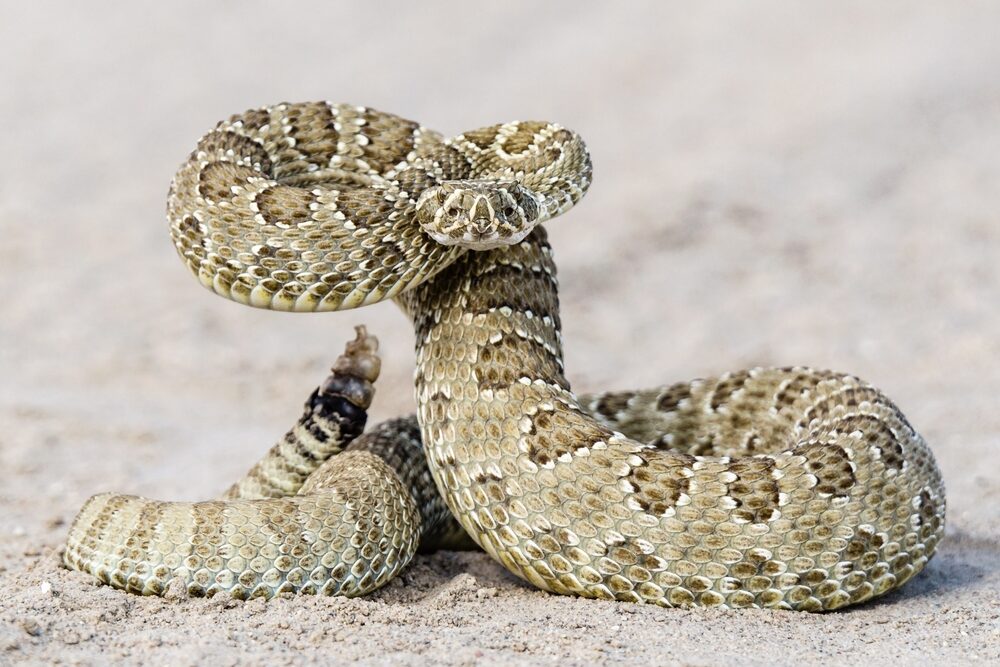
Stretching across the Great Plains, from Canada to Texas, the prairie rattlesnake is a master of survival in open landscapes. It thrives in grasslands, rocky outcrops, and even agricultural fields, where it hunts rodents, birds, and lizards. Unlike some of its more aggressive relatives, this rattlesnake tends to be more reserved, often relying on its camouflage to avoid detection. But if cornered, it doesn’t hesitate to rattle its tail in warning. If that warning is ignored, the next move is a lightning-fast strike.
The venom of a prairie rattlesnake is a mix of hemotoxins that destroy tissue and anticoagulants that prevent blood from clotting. A bite can cause intense pain, swelling, and serious complications if not treated promptly. While it’s not as large as some other rattlers, its venom is nothing to take lightly. Hikers and outdoor workers in the Midwest and western states should always be mindful of their surroundings, especially in tall grass where these snakes can be easily overlooked.
9. Sidewinder
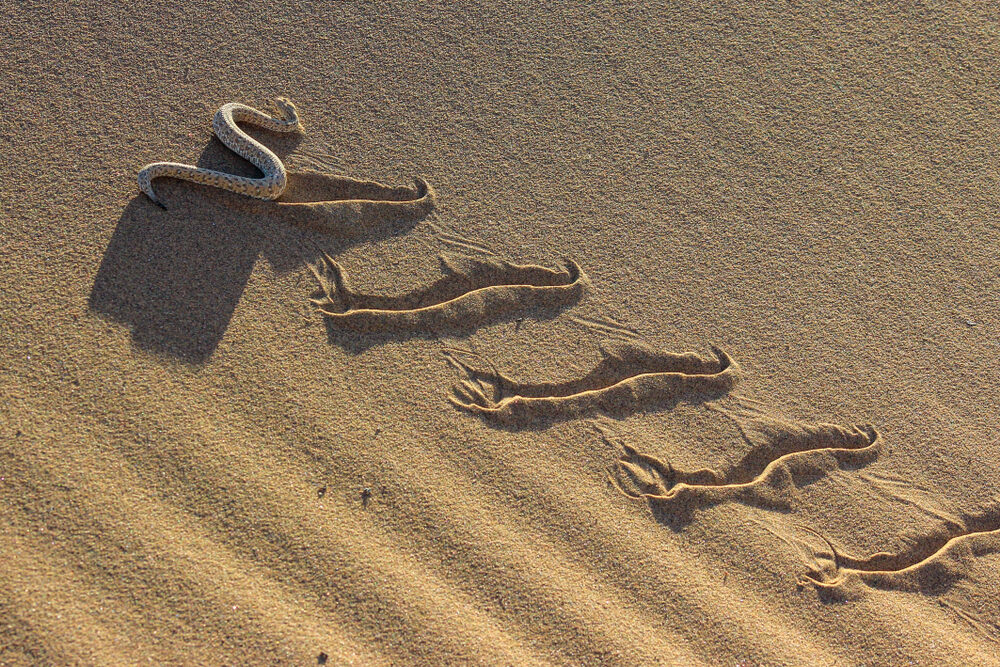
If you’ve ever seen a snake moving in that weird, sideways motion across the sand, you were probably looking at a sidewinder. These rattlesnakes are built for life in the desert, and their unique movement helps them stay cool by minimizing contact with the scorching sand. Found in the southwestern U.S., especially in California, Nevada, and Arizona, sidewinders are small but incredibly fast, making them efficient predators in their harsh environment.
Their venom isn’t the most potent among rattlesnakes, but it’s still dangerous. A bite can cause intense pain, swelling, and tissue damage. Fortunately, sidewinders are not aggressive, and their small size means they don’t inject as much venom as larger rattlers. But don’t be fooled—if threatened, they will strike quickly. Their ability to blend in with the desert floor makes them easy to miss, which is why people sometimes get too close without realizing it. For anyone trekking through the desert, keeping an eye on the ground is always a smart move.
10. Black-tailed Rattlesnake

The black-tailed rattlesnake is one of the most visually striking venomous snakes in the U.S. With a golden-brown body and a sleek black tail, it’s a standout species found in the southwestern states, particularly in Texas, Arizona, and New Mexico. Unlike some rattlesnakes that favor dry, open terrain, the black-tailed rattlesnake is just as comfortable in rocky mountain slopes as it is in deserts and forests.
Its venom is powerful but not as aggressive as some of its relatives. A bite can cause intense pain and swelling, but fatalities are rare thanks to the availability of medical treatment. What makes the black-tailed rattlesnake unique is its calm temperament—it’s less likely to strike unless seriously provoked. Still, like any rattlesnake, it’s not to be taken lightly. If you ever encounter one while hiking, the best approach is always the same: back away slowly and give it space.
11. Canebrake Rattlesnake

A close cousin of the Timber rattlesnake, the canebrake rattlesnake is found in the southeastern U.S., particularly in swamps, river bottoms, and forests. It has a striking pattern of dark crossbands over a gray or pinkish body, making it both beautiful and deadly. Unlike some rattlesnakes that prefer rocky outcrops or desert landscapes, the canebrake thrives in humid environments, often near water sources.
Its venom is a serious mix of neurotoxins and hemotoxins, making it one of the most dangerous rattlesnakes in North America. A bite can cause paralysis, respiratory failure, and severe internal bleeding if not treated immediately. Though it’s generally not aggressive, it will stand its ground if provoked. Many bites occur when people accidentally step too close, mistaking it for a harmless snake. For those who spend time outdoors in the southeastern U.S., learning to recognize this species could be a lifesaver.
12. Desert Massasauga
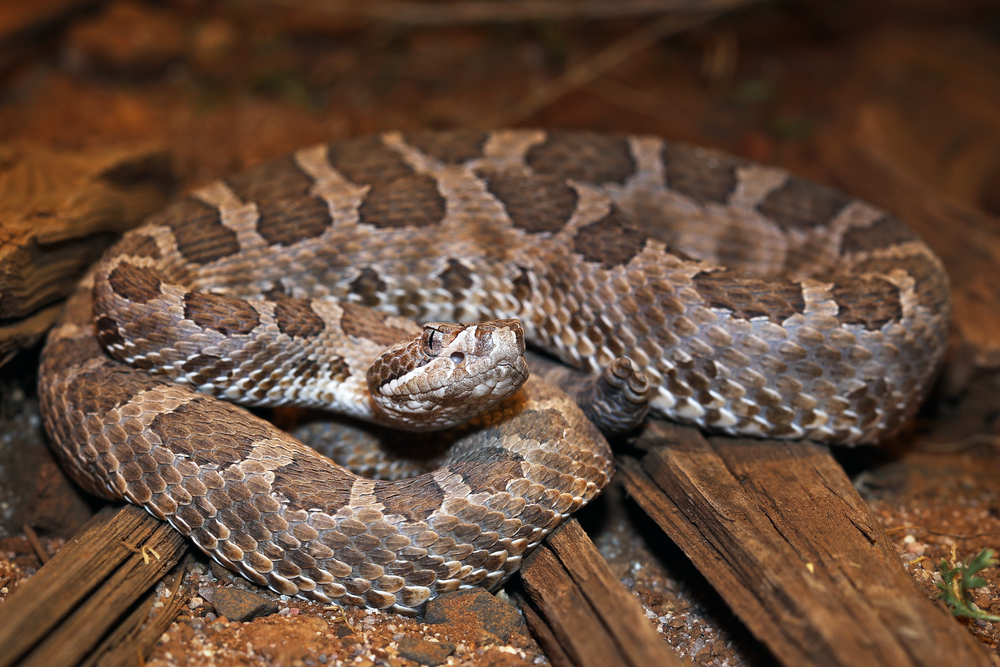
The desert massasauga is one of the smallest venomous snakes in the U.S., but what it lacks in size, it makes up for in toxicity. Found in parts of Texas, New Mexico, and Arizona, this rattlesnake prefers dry, rocky terrain where it can blend in effortlessly with its surroundings. Unlike its larger relatives, it has a more subtle rattle, which makes it harder to hear if you’re not paying attention.
Its venom is a potent hemotoxin that causes extreme pain, swelling, and potential tissue death. Because of its small size, it doesn’t inject as much venom as larger rattlesnakes, but that doesn’t mean a bite is harmless. The real danger comes from its elusive nature—hikers and ranchers often don’t see it until they’re too close. Its preference for remote, rugged areas means bites are rare, but when they do happen, they require immediate medical attention.
13. Eastern Coral Snake
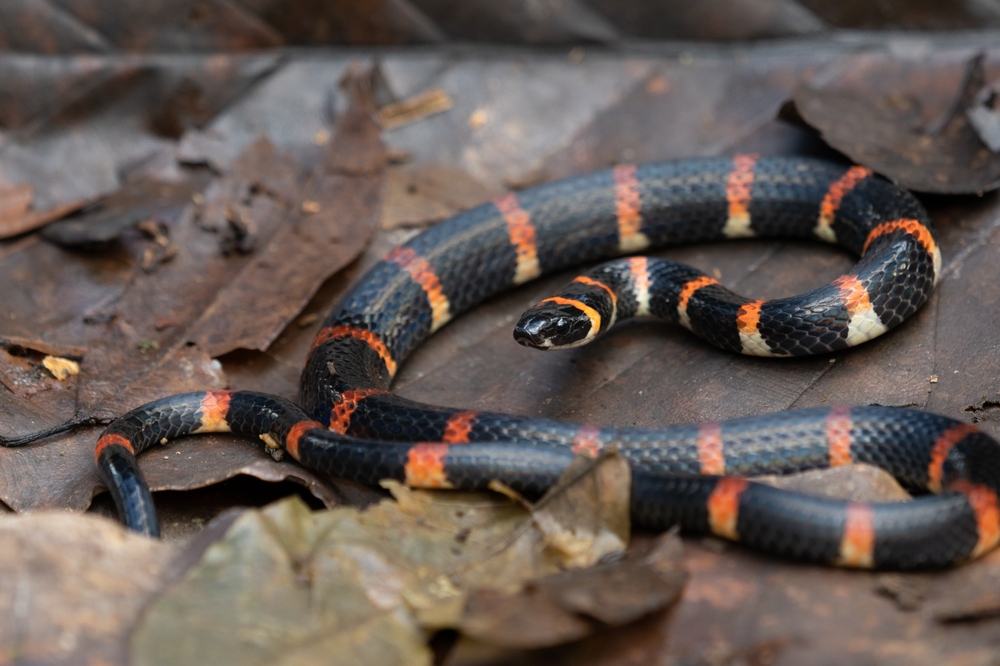
The Eastern coral snake is the more secretive cousin of the previously mentioned coral snake species. Found in the southeastern U.S., from North Carolina to Florida, it prefers dense woodlands and sandy pine forests. This snake is small and reclusive, spending most of its time hidden under debris or burrowed underground. Because of its secretive nature, bites are extremely rare—but when they happen, they are life-threatening.
Its venom is pure neurotoxin, shutting down the nervous system and leading to respiratory failure if untreated. Unlike rattlesnakes, which strike quickly, coral snakes have to chew on their prey to inject venom. This makes human bites less common, but their potency is nothing to underestimate. Many people mistake them for harmless milk snakes, which can lead to dangerous encounters. The best rule of thumb? If you see bright red, yellow, and black bands, steer clear.


